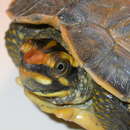Biology
provided by Arkive
The crowned river turtle is primarily a herbivorous reptile, consuming a diet of aquatic plants and vegetation that falls into the water (2) (3), although it may also occasionally feed on freshwater shrimp, small fish (2), and frogs (3). Like all turtles, this species has no teeth, and instead uses its sharp jaws to cut food (4). When not feeding, it spends much of its time resting on the bottom (3), burying itself into the mud if it feels threatened (2). At other times, it may be seen floating quietly at the surface of the water as it basks in the warmth of the sun (3).
Courtship in the crowned river turtle is said to take place from April to July, when the male uses his forelimbs to produce a drumming sound and some mouth to mouth contact may occur between the male and female, before mating (3). Nesting has been reported to take place between August and January, with the exact timing depending on the location (2) (3). Using its hindlimbs, this turtle digs a nest in sandy soil, into which 14 to 19 elongated eggs are laid. The hatchlings, which have more brightly coloured shells than the adults, measure around just six centimetres long (3).
Conservation
provided by Arkive
There are currently no specific conservation measures known to be in place for this threatened turtle.
Description
provided by Arkive
The crowned river turtle is a large freshwater reptile, with a dark grey, brown or black upper shell (carapace). The borders between the large bony plates that make up the shell are yellow and the rim of the shell may also be yellow (2) (3). The undershell of the crowned river turtle is yellow with a large dark blotch on each scute. The brown or black head, patterned with several yellow stripes, has a rounded and rather short snout (3). All four of the limbs bear webbed toes, perfectly suited to their aquatic habitat, and are brown or dark grey edged with yellow or cream (2) (3). Male and female crowned river turtles differ remarkably in their appearance, with males being just one third the length of females (2). The small males also have a thicker and longer tail and the undershell is slightly concave (3).
Habitat
provided by Arkive
This semi-aquatic turtle inhabits rivers, canals, lakes and ponds, where it is found in areas with little current, abundant aquatic vegetation, and muddy bottoms (1) (2) (3). Very rarely, it will come out of the water to bask (2).
Range
provided by Arkive
The crowned river turtle occurs in Pakistan, northern Indian, Nepal and Bangladesh (1), in the watersheds of the Ganges, Brahmaputra, and Indus rivers (3).
Status
provided by Arkive
Classified as Vulnerable (VU) on the IUCN Red List (1).
Threats
provided by Arkive
This turtle is considered to be vulnerable to extinction (1), after hunting has left populations decimated (2). For many years the flesh of this large turtle has been eaten by people, and it can still be found for sale in the markets of India and Bangladesh. Sometimes this species is also collected for export to China (2).

